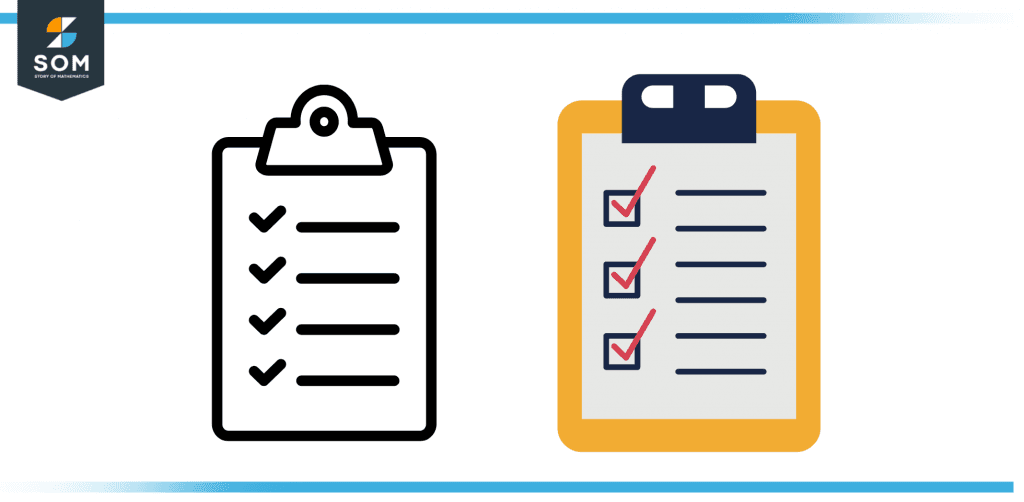JUMP TO TOPIC
Survey|Definition & Meaning
Definition
A survey is a means of gathering information about something. There are many kinds of surveys for various purposes: to learn about general trends, gather opinions, plan for something, or check for legal compliance. For example, before building a farm, it would be good to measure the soil’s quality and define the farmland’s size and boundaries (called a farmland survey).
In mathematics, a survey is a technique for gathering data that involves posing a series of questions to participants in order to learn more about their attitudes and actions.
This is the most typical and affordable form of data collection. The sample size can change depending on the situation. It might be carried out in the:
- a classroom to learn about the pupils’ preferred flavors of ice cream
- a nation that gathers data on people’s political views

Figure 1 – Surveys are statistical in nature, with pie charts and other graphs often used to summarize their results.
Kids’ Survey Definition
A survey is a method for gathering data in which a series of questionnaires are used to learn more about a person or group of people.
It is beneficial to gather information on people’s attitudes and actions. For instance, knowledge of consumer purchasing patterns can be used to assess product demand better and increase sales.
Why Do People Use Surveys?
A survey’s data is thoroughly examined in order to derive findings and make projections. For example, some common surveys include:
- Ratings for Television Programs.
- Student preferences in school sports.
- Citizens’ political leanings in a given country.
- Activities that members of a particular society prefer to engage in.
Let’s take the scenario where a restaurant wants client input on a new dish. The most effective way to achieve this is to conduct a survey & ask a few pertinent questions of the clients. In this method, the restaurant will learn what its patrons think of the meal and can adjust.

Figure 2 – A typical questionnaire and checkbox survey.
Types of Surveys That Are Typically Used
The term “survey method” is used to describe the procedure taken to accumulate information. Depending on the type of data or understanding you need, you may need to resort to a certain methodology.
Different Types of Surveys
Here are some of the most typical approaches:
Survey Tool
It is made up of online questions that anyone may look at. This strategy is efficient, simple to use, and economical; it may also be used to gather data from a huge population with little effort.

Figure 3 – Online survey
Report Questionnaire
It is the tried-and-true approach to surveying that involves using pen and paper. It’s useful for reaching people who aren’t comfortable with technology. This approach, however, can often be more time-consuming and costly.
Survey via Telephone
Telephonic surveys, as the name suggests, are carried out via telephone. Participants are called by phone and asked a series of questions. If respondents are hesitant to spend enough time on the phone, this approach might be inefficient and time-consuming.
Direct Meeting or Conversation
Interviewers arrange to meet up with responders in person and ask questions that way. The replies provide lengthy, detailed answers in their own words to the questions posed. When a deep understanding of a topic is required, yet the target audience has poor literacy levels, this approach may prove useful.
Nonetheless, the time and money required to implement this strategy are significant.
Creating Survey Questions
Cartoon depicts a man holding up a survey sheet for viewers to fill out.
To gather information from a respondent, questions or other prompts are compiled into what is called a questionnaire. A questionnaire’s results can be either qualitative or quantitative in nature. The validity and trustworthiness of our survey findings will depend on how well we design the questionnaire.
Choosing the incorrect questions may make or break a survey, and a proper questionnaire ensures that we acquire the information we need in a timely manner with minimal effort. Because of this, we must construct our survey questions carefully.
The following are examples of some frequently asked questions.
Free-form Queries
Questions that are open-ended encourage responders to provide detailed responses about their thoughts and feelings. The purpose of asking such questions is to learn more about the respondents’ inner experiences.
So, for instance, what are your thoughts on the status of women in your country?
MCQs: Questions With a Choice
When answering a multiple-choice question, you can choose one or more of the possible responses. We can ask objective questions when we’re interested only in the respondents’ choices and not their motivations.
What’s your favorite flavor of ice cream, for instance?
- Strawberry
- Affable Chocolate-Vanilla
- Indulge in a mouthwatering Blueberry Butter Pecan Pie
- Asking About an Interval Scale
This is a multiple-choice question in which the respondent is given a set of possible answers.
Similarly, a prompt like “Explain how you feel about size issues when purchasing clothing products online” may have the options:
- It is not a problem for me.
- It is sometimes a problem, but the store cooperates with returns and other options on receiving a bad fit.
- I can never find the right size online.
Another common format is to structure the questions’ choices using a ratio scale. These inquiries necessitate quantifiable response options. For example, how much time do you typically devote to online social networking sites like Facebook, Twitter, Instagram, etc.?
- 0–1 hour
- 1-2 hours
- 2-3 hours
Steps for Conducting a Survey
The procedure for carrying out a survey consists of the six steps listed below.
1. Choose the Survey Target
You should know why you’re conducting a survey and what information you hope to glean before you begin. Based on this, you’ll decide the next steps, like who to survey, what data to collect, etc.
Take the case of a housing society association leader who wants to construct a leisure club in the community. You intend to conduct the survey to learn about the leisure pursuits of every member of your community for this purpose. As a result, the people who are actually part of the society are those you will be surveying.
2. Select the Survey Method
The nebxt thing to do is figure out how we’ll really go about gathering all this data.
Methods for conducting surveys are selected with consideration given to factors such as population size, data type, available resources, etc.
In the first step, for instance, the method can be selected according to the size of the neighborhood; if the area is relatively small, data can be collected with the help of volunteers using paper or telephone methods.
If most of your group’s members are also active in social media groups, it’s probably best to do business online.
3. Formulate the Survey
The next move is to create the survey. Your survey’s questionnaire’s structure and questions should be determined by the data you hope to collect.
In order to create the activity club we’re considering, the association’s leader would need information about the members, such as their top leisure activity, the best time of day for the club to meet, etc.
These are factual inquiries; a mix of two or three varieties is appropriate.
4. Send the Survey to the Target
The next phase involves administering the survey to the population sample.
5. Arrange the Collected Information for Analysis
If you’re having trouble making sense of the preferences/trends, you might benefit by arranging the data graphically or in a table.
You might, for instance, compile the data inside the spreadsheet and employ it to make a pie chart showing people’s preferences for activities and a separate graph showing people’s preferences for time slots.
6. Draw Conclusions Based on Survey Results
Take a look at the charts and tables you made in the previous section.
If the graph shows that more people are interested in soccer than any other sport, then you may create a team dedicated to that activity.
You can do the same thing with a time slot graph to figure out when to open your club.
A Numerical Example of a Survey
Which age group would be the most appropriate to conduct a survey on if it were to be done on the work-life balance of working people in a city?
- 0–10 yrs
- 11–19 yrs
- 20–65 years
- Over the age of 65
Solution
The correct answer is between 11 and 19 years old.
All mathematical drawings and images were created with GeoGebra.
